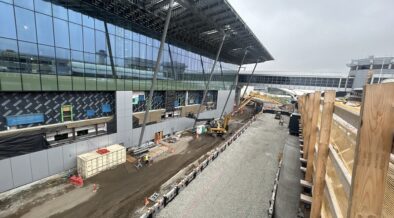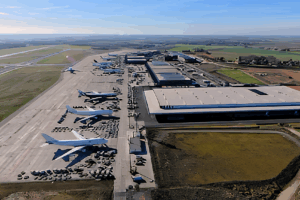
Infrastructure Engineering Inc.’s David Robbins provides his thoughts on how early alignment and relationship building can transform aviation infrastructure projects in the United States.
Airports at major airports, project delays and cost overruns are often blamed on ‘unforeseen conditions’, but most so-called surprises aren’t surprises at all, they are symptoms of poor early engagement.
When operational voices are brought into project planning from day one, airports gain more than smoother construction. They gain infrastructure that works better, lasts longer, and adapts faster to future needs.
The key to early alignment? Listening, humility, and a genuine respect for the expertise that comes from living with infrastructure every day.

THE INFRASTRUCTURE CHALLENGE
In an era of aging infrastructure and surging travel demand, modernising America’s airports requires more than technical expertise – it demands strategic alignment, early stakeholder engagement, and a deep understanding of the people behind the projects.
Aviation infrastructure is complex by its nature and complicated by governance, regulatory oversight, and the diverse needs of its end users.
Yet, within this layered landscape lies an opportunity: to redefine how major infrastructure projects are delivered, not just on time and on budget, but with long-term operability and community value in mind.
Success hinges on eliminating complications before they arise and building the foundations for success long before the first shovel hits the ground.
That foundation starts with clarity. You’re given a scope of work, you do an assessment, and you figure out who needs to be in the room. From there, it’s about aligning expectations: is the scope correct? Is this what the client really wants? Is this what’s truly needed?

If the answer is yes, the project moves forward. If not, that moment becomes a checkpoint – a chance to recalibrate, revisit the design contract, and ensure that any necessary changes are captured before moving ahead.
In aviation, where stakes are high and complexity is baked in, this kind of intentionality is not a luxury – it’s a necessity.
DEFINING SUCCESS: WHY EVERY PROJECT MUST START WITH THE END USER
Every successful project begins by asking: Who will use this? And how will it operate? Yet too often, early project definitions are vague or misaligned with operational realities, setting the stage
for complications.
That’s why successful teams begin with listening – grounded in humility and a deep respect for the expertise of airport stakeholders who work with these systems every day.
In existing aviation infrastructure – whether terminal upgrades, runway rehabilitation, airfield paving or cargo expansions – the design must reflect the operational demands.
Factors like aircraft type, utilisation rates, environmental conditions, and operational requirements dictate critical decisions, from pavement thickness to marking layouts. If designing for Group V aircraft versus Group III, the entire infrastructure shifts accordingly.
Getting project definitions right starts by recognising that the deepest expertise lies with those who live with the results every day – maintenance personnel, operating engineers, ground crews, and the airlines themselves.
Engaging these stakeholders early enables progressive commissioning throughout design and construction, ensuring that each system is tested, validated, and fine-tuned as it comes online – so by the time the project is complete, it’s not just built to spec, it’s built to perform, with the people who run it already aligned and ready.

Since joining Infrastructure Engineering Inc. (IEI), I’ve come to appreciate the firm’s commitment to aligning stakeholder interests as a foundation for successful project delivery – a philosophy that resonated with me from the start.
That commitment came into sharper focus during a conversation with Alex Kline, who leads IEI’s Indianapolis office, when he shared the team’s approach to modernising the 64-acre economy parking lot at Indianapolis International Airport.
Though it appeared to be a routine rehabilitation project, it posed complex challenges given its scale and operational importance as a key revenue source with over 8,000 spaces. The team’s solution – marked by careful co-ordination, strategic phasing, and a strong customer-first mindset – demonstrated how thoughtful planning can turn complexity into opportunity without disrupting essential operations.
The phased rehabilitation highlighted the importance of operational co-ordination even in landside projects. The 17-year-old lot required substantial renovation, but maintaining shuttle service throughout construction was non-negotiable.
Crews had to navigate heavy shuttles through shifting construction zones, rerouting traffic while keeping active areas safely separated. The challenge extended beyond logistics – success depended on constant communication with stakeholders to ensure that every operational adjustment was clearly understood and customer service remained uninterrupted.
Through careful phasing and collaborative problem-solving, the team preserved functionality while delivering long- overdue improvements.
AVOIDING COSTLY SURPRISES
One of the biggest opportunities for project success lies in involving the right people early enough. Transparent collaboration with those who know the systems best helps avoid surprises
and lays the groundwork for well-informed, proactive solutions.
Every airport project has someone who knows the full history, the buried utilities, the shortcuts taken decades ago. If they aren’t consulted upfront, surprises are inevitable.
For example, when installing new systems in one of the largest centralised refrigeration plants in the country at Chicago O’Hare, success depended on co-ordinating critical shutdowns without impacting passenger comfort.
Executives alone weren’t enough; early design discussions included United Airlines representatives, terminal managers, operating engineers, and maintenance staff. Their feedback uncovered system conditions that would have been invisible otherwise – systems laid more than 50 years ago that needed special handling.
Involving operational voices from the outset ensures that solutions are rooted in on-the-ground realities and informed by those who know the airport best.
BUILDING TRUST BEFORE BREAKING GROUND
Aviation infrastructure projects can involve a dizzying array of stakeholders each with their interests and procedures. These could include city departments, environmental agencies, airlines and regulatory bodies.
Bureaucracy often gets a bad rap, but it’s a reality of the process and one that shouldn’t be ignored or vilified. Designers, project managers, and practitioners may be quick to complain, but real progress comes from understanding how the system works and navigating it effectively. Bureaucracy exists for a reason: checks and balances that ensure accountability.
The most effective approach is to build relationships that humanise it. Consensus-based negotiation, built on trust, is a powerful tool.
During the streamlining of the O’Hare Modernization, for instance, when procurement delays threatened to stall the project, we didn’t just wait for reviews to come through. We aligned closely with
our design engineers, scheduled face-to-face meetings with procurement, brought donuts, and collaborated in real time.

It wasn’t about shortcuts – it was about showing up, asking the right questions, and making it easier for people to do the work they already want to do.
Bureaucratic steps don’t disappear, but by leaning into the process and engaging with it thoughtfully, you build relationships and, ultimately, partnerships that move the work forward.
Programme progress came not through a confrontational spirit, but through finding allies and building personal connections. In one case, a breakthrough occurred after a conversation over coffee with a key water engineer, establishing trust through shared stories and experiences.
This relationship allowed an eight-year bureaucratic log jam involving many layers of the system to be resolved in a single afternoon.
Humanising the process moves projects forward. Trust makes it possible to simplify agreements, obtain consensus, and avoid institutional stalemates that involve significant timeframe at substantial cost.
DEMYSTIFYING THE CONTRACT
Many consultants approach contract conversations from the outside looking in but, having sat on the other side of the table, it’s clear that trust and transparency are everything.
Successful project delivery depends not just on technical execution, but on ensuring that every stakeholder – owners, operators and contractors – come to the table with shared expectations and a clear understanding of how decisions will be made.
Many project disputes seem to stem from a simple yet avoidable issue: stakeholders not fully understanding the contract. Too often, critical terms around change management, decision-making, and execution go unnoticed because the contract isn’t thoroughly read.
But the contract is more than legalese, it’s a roadmap for how the work will get done. When project managers, design engineers or owners actively flag key provisions, it empowers the entire team.
Understanding the contract means understanding the rules of engagement, the decision-making thresholds, and what each party is responsible for, ultimately reducing risk and improving outcomes.
Kick-off meetings aren’t just ceremonial, they’re foundational. They create space for the project team to establish a shared understanding of how the contract will be administered, how changes will be managed, and how conflicts will be resolved.
These conversations align clients, consultants, contractors, and end users around the rules of engagement. Even more powerful is the opportunity to help write the contract itself.
Drafting a contract deepens your understanding of its structure, logic, and intent. It transforms the document from a static set of terms into a dynamic tool shaped by experience and lessons learned. Rather than handing it off to legal, those who embrace the process gain valuable insight, and strengthen their ability to lead projects more effectively.
By establishing shared understanding of contract terms early, teams create a culture of transparency, shared knowledge, and proactive decision-making, setting everyone up for long-term success.
This alignment isn’t just procedural as it builds a culture of mutual respect and accountability from day one.

LESSONS FROM THE AIRFIELD
In my experience, project success is rooted in clarity of purpose. Defining a project isn’t just a technical exercise, it’s relational. Understanding the ‘who’ and the ‘why’ before defining the ‘how’ saves time, money, and frustration down the road.
Inclusion creates operability. By engaging operators, maintainers, and users at the earliest stages, projects benefit from deeper operational insight, fewer disconnects, and greater long-term functionality.
Proactive alignment saves time and money. When stakeholders align early on process and expectations, they collaborate more productively when the inevitable challenges arise. A clear understanding of the contract, and the processes for change, minimises costly delays.
Human connection drives institutional change. True transformation happens not just through formal channels, but through relationships. Trust, built one conversation at a time, becomes the catalyst for better decisions and smoother execution.
Reframing Complexity: A new mindset for a new era. Aviation infrastructure projects will always be complex. But they don’t have to be complicated.
Transparency fosters teamwork: Open communication, shared information, and mutual understanding of project goals lead to better decisions and stronger outcomes for everyone involved.
When project leaders distinguish complexity from complication, and address it proactively through early alignment, intentional inclusion and strategic relationships, they create infrastructure that isn’t just technically excellent but deeply resilient.
Take O’Hare International Airport, for example. At the time, it was the largest civil works project in the US —a $13.5 billion programme that realigned all runways, constructing four new ones, extending two and decommissioning three crosswind runways and a basin, and kept operations running without disruption.
This was accomplished while the airport was growing in both personnel and aircraft movements and operating under strict gate constraints.
The project team didn’t just manage technical logistics, they navigated regulatory restrictions, operational demands and physical constraints to essentially build a new airport on top of an existing one. The success of this effort came down to strategic foresight, proactive co-ordination, and early stakeholder alignment. Incidentally, for that project, I was on the agency side of the table – and IEI was one of the firms helping deliver that massive transformation.
The lesson? Complexity doesn’t have to derail a project. Successful delivery isn’t just about systems, specifications, or schedules. It’s about people. It’s about trust. It’s about getting it right the first time.
When teams focus on early alignment, inclusion, and human connection, they set the stage for aviation projects that don’t just meet technical goals but elevate the communities they serve.
About the author
David Robbins ([email protected]) is vice president and aviation business practice lead at Infrastructure Engineering Inc (IEI). IEI has a strong track record delivering airside and landside aviation infrastructure solutions with clients that include O’Hare, Midway, Newark, LaGuardia, Hartsfield-Jackson Atlanta and Indianapolis airports.
Learn more at https://www.infrastructure-eng.com/






